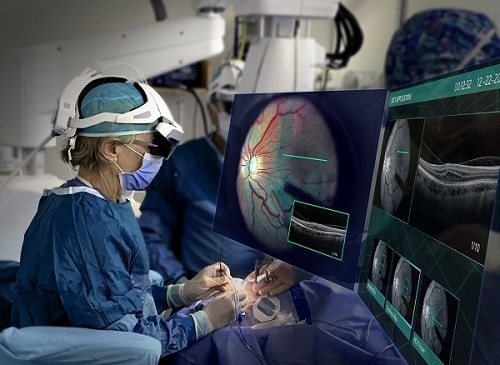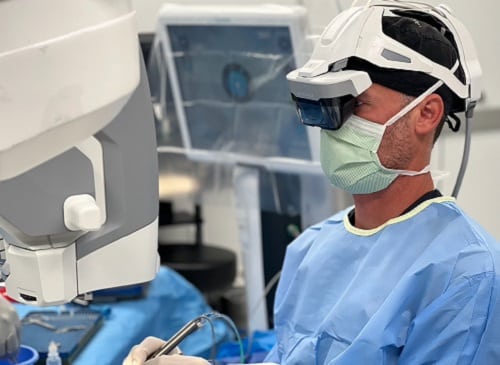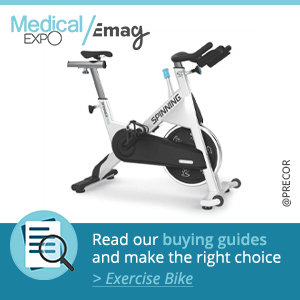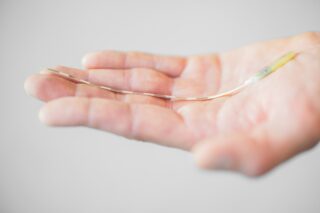Medical device company Beyeonics Vision has launched a new ophthalmic exoscope and surgical augmented reality (AR) headset to provide surgeons with enhanced visualization and control. The Beyeonics One was inspired by head-mounted display technologies used by pilots and is designed for use in a range of ophthalmic procedures, including retina, cataract, glaucoma and corneal surgeries.
An exoscope is a high-definition, fully digital imaging platform that enables surgeons to see magnified 3D images of the surgical field. The Israeli company Beyeonics Vision is a spinoff of aviation technology operation Elbit Systems. Efi Zaritzky, VP Marketing at Beyeonics, explained:
“We realized the technological uniqueness of pilots’ head-mounted visualization and control could create unprecedented value also in other fields, specifically surgical operations.
Presentation of accurate information in real time is critical to the quality of pilots’ performance and this is a significant common denominator between pilots and surgeons.
The Beyeonics One is designed to deliver enhanced visualization and on-demand, consolidated, pre-operative data, which are naturally accessible and controlled by an immersive AR surgical headset.”
Improving Surgical Outcomes and Efficiency
Beyeonics Vision was established to empower surgeons with operating theater surgical digital consolidating platforms. These employ enhanced imaging, advanced processors, artificial intelligence (AI) and navigation technologies within an immersive AR surgical headset display and control unit.
Ms. Zaritzky said:
“The automated processes provide surgeons with valuable information and decision guidance that create a synchronized surgical environment.
What sets the Beyeonics One apart is its AR headset. The use of a lightweight, adjustable AR surgical headset display and control unit overcomes microscopy and monitor constraints.


“Head gestures are used seamlessly to control frequent functions such as focus, zoom, pan and illumination and are also used to toggle through various overlays. A meaningful teaching and learning experience is enabled by the ability to connect up to three surgical headsets simultaneously, with face-to-face or 90 deg viewing options and additional guidance features.
The goal is to increase the amount and quality of real-time data that is presented to surgeons in a seamless fashion, increase the signal-to-noise ratio of surgical data, and improve surgical outcomes and surgical efficiency.”
Inside the Eye
The augmented reality surgical headset brings the surgical field right in front of the surgeon. The untethered visualization and ergonomic-friendly design allow for adaptation of a more natural posture, demonstrated to increase surgeon’s well-being, productivity and professional longevity.

Prof. Paulo Eduardo Stanga, Vitreoretinal Surgeon and Director at The Retina Clinic in London, has operated on patients using the device. He said:
“I was very impressed by the short learning curve and perhaps most importantly by the immersive experience I got as a surgeon. It felt like being inside the eye itself during surgery and I found this especially helpful when treating the vitreoretinal periphery.
I believe this is a game-changing technology for vitreoretinal surgery.”
Additional Medical Fields
According to Ms. Zaritzky, the Beyeonics One will be key to the advancement of global eye healthcare. She said:
“Microscopes are used in every ophthalmic surgical procedure. Optical microscopy is an excellent and time-proven method that has been invented over 100 years ago, but it is limited with further improvements. It has reached a plateau.
On the other hand, digital systems can improve orders of magnitudes beyond current capacities. We can predict improvements in real-time image processing, coupled with innovative commingling image presentation to surgeons and trust the digital platform will replace the standard scopes in every surgical procedure.”


The Beyeonics One is an evolving platform. The plan for the future is to integrate it with other operating theater platforms and offer connectivity for remote teaching. She added:
“We are also working to further enhance the development and offering in additional medical areas such as orthopedics and neurosurgery.
In these areas, the benefits of immersive technologies such as AR and VR are well known for accuracy and clinical efficacy.”











